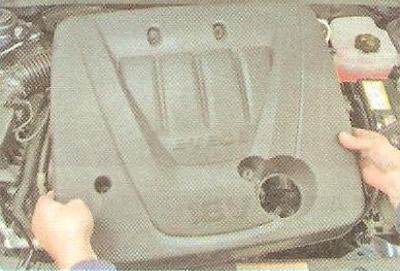
For easier access to the sensors, remove the decorative engine cover (see «Removal and installation of a decorative casing of the engine»).

coolant temperature sensor installed on the right side of the cylinder head between the 1st and 2nd cylinders. The sensor is an NTC thermistor: the electrical resistance of the sensor decreases with increasing temperature. The controller processes the sensor signal and sets the optimal enrichment of the working mixture when the engine warms up.
At the coolant temperature sensor, check the resistance at its terminals under various temperature conditions.
You will need: key «at 19», tester, thermometer.
1. Disconnect the wire from the terminal «minus» battery.
2. Drain the coolant (see «Coolant replacement»).
Helpful advice: The coolant can not be drained, it is enough to plug the hole with a finger or a plug after removing the sensor, then the loss of coolant will be minimal.
3. Wring out a clamp and disconnect a block of a plait of wires from the gauge of temperature of a cooling liquid.

4. Loosen the sensor tightening with a wrench...

5.... and unscrew it from the cylinder head.

Note: The connection of the sensor to the cylinder head is sealed with a washer. Replace a heavily compressed washer.

6. Cool the sensor down to ambient temperature. Connect the tester in ohmmeter mode to the sensor terminals and measure its resistance. Measure the current air temperature with a thermometer and compare the obtained values \u200b\u200bwith the data in Table. 10.6. If the resistance deviates from the norm, replace the sensor.
Table 10.6. Dependence of the resistance of the coolant temperature sensor on temperature
| Temperature,°С | Sensor resistance, Ohm |
| 100 | 176 |
| 90 | 246 |
| 80 | 327 |
| 70 | 441 |
| 60 | 603 |
| 50 | 837 |
| 40 | 1180 |
| 30 | 1700 |
| 20 | 2500 |
| 10 | 3760 |
| 0 | 5800 |
| -5 | 7273 |
| -10 | 9200 |
| -15 | 11722 |
| -20 | 15 080 |
| -30 | 25 600 |
| -40 | 45 300 |

7. To measure the resistance at the sensor terminals under various temperature conditions, lower the sensor into hot water and check the change in its resistance as the water cools, controlling the water temperature with a thermometer. Nominal resistance values at different temperatures are shown in Table. 10.6.
8. Install the sensor in the reverse order of removal.
9. Fill in coolant.

intake air temperature sensor screwed into the hole in the air supply sleeve near the air filter. The sensor is an NTC thermistor. Based on the air temperature information from the sensor, the controller regulates the amount of fuel injected.
The air temperature sensor checks the resistance at its terminals under various temperature conditions.
1. Turn off the ignition.

2. Squeeze the spring clip and disconnect the wiring harness block from the sensor.
3. Connect the tester in the voltmeter mode to the terminals of the wiring harness block, turn on the ignition and measure the sensor supply voltage. The voltage should be (5±0,2) IN.
4. Unscrew the sensor.
5. Connect the tester in ohmmeter mode to the sensor terminals and measure its resistance. Measure the current air temperature with a thermometer and compare the obtained values \u200b\u200bwith the data in Table. 10.7. If the resistance deviates from the norm, replace the sensor.
Table 10.7. Intake air temperature sensor resistance versus temperature
| Temperature,°С | Sensor resistance, Ohm |
| 100 | 176 |
| 90 | 240 |
| 80 | 331 |
| 70 | 466 |
| 60 | 668 |
| 50 | 977 |
| 40 | 1631 |
| 30 | 2238 |
| 20 | 3515 |
| 10 | 5672 |
| 0 | 3452 |
| -5 | 12 291 |
| -10 | 16160 |
| -15 | 21427 |
| -20 | 28 660 |
| -30 | 52705 |
| -40 | 100 780 |

Knock sensor attached to the top of the cylinder block.
You will need a key «at 14».
1. Disconnect the wire from the terminal «minus» battery.

2. Press the spring clip and disconnect the knock sensor harness connectors.

3. Loosen the tightening of the bolt securing the sensor to the engine block with a wrench...
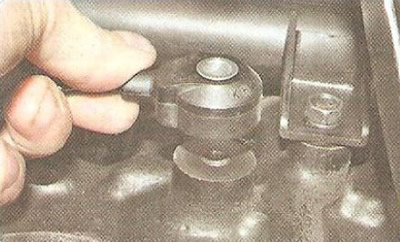
4.... and, having unscrewed the bolt by hand, remove the knock sensor.
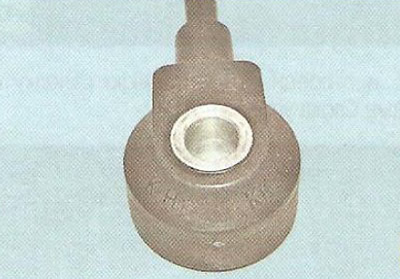
Note: Pay attention to the labeling of the sensor in order to purchase a similar knock sensor for replacement.
5. Install the knock sensor in reverse order. Tighten the sensor mounting bolt to 20 Nm.
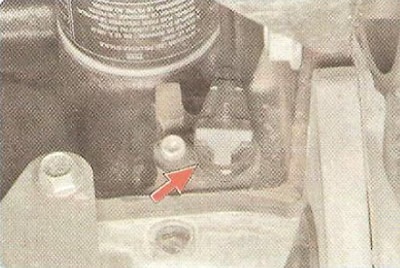
Engine crankshaft position sensor, consisting of a magnet and a winding, is installed at the rear of the engine block.
If a malfunction occurs in the crankshaft position sensor circuit, the engine stops working, the controller stores the malfunction code in memory and turns on the warning lamp in the instrument cluster. In this case, check that the sensor is working properly.
You will need: hex wrench «by 5», tester.
1. Disconnect the wire from the terminal «minus» battery.

2. Squeeze the spring clip...
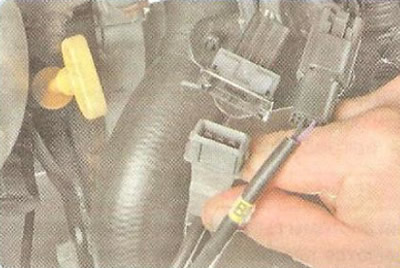
3.... and disconnect the crankshaft position sensor harness connector.

4. Turn out the screw of fastening of the gauge to the block of cylinders of the engine and take the gauge from an aperture of the block of cylinders.

5. Connect the tester probes and measure the resistance at the terminals «1» And «2» sensor. The nominal value of the resistance should be in the range of 500-600 ohms. If the resistance is not within the specified limits, replace the sensor.
6. Install the crankshaft position sensor in the reverse order of removal.

Phase sensor installed in front of the cylinder head between the toothed pulleys of the camshafts. The principle of its operation is based on the Hall effect. On the camshaft pulley (graduation) the master segment is completed. When a pulley area without a segment is opposite the sensor, a low level signal is sent from the sensor to the ECU (approx. 0 V), and when the sector enters the measuring area of the sensor, a pulse occurs on the ECU «reference» voltage (about 5 V).
You will need: key «on 10», flat blade screwdriver.
1. Disconnect the wire from the terminal «minus» battery.
2. Remove the upper timing cover (see «Checking the timing belt»).

3. Wring out a clamp of a block of a plait of wires...

4.... and disconnect the block from the phase sensor connector.

5. Turn out two bolts of fastening and remove the phase sensor.
6. Install the sensor in the reverse order of removal.

Manifold absolute pressure sensor installed on the intake pipe. The sensor captures the change in pressure (rarefaction) in the intake pipe depending on the load and engine speed and converts it into an output signal voltage. The ECU supplies the sensor with a supply voltage of 5 V and processes its signals from the signal transmission circuit. The sensor is connected to «weight» through its variable resistor. Depending on the sensor signal, the ECU calculates the amount of air entering the engine.
You will need: key «on 10», voltmeter.
1. Check the power supply circuit of the sensor. For this...
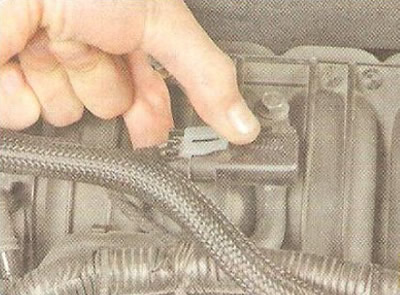
2.... press the latch...
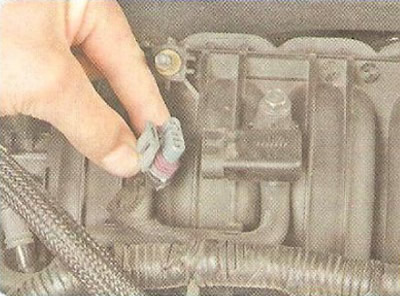
3.... and disconnect the wiring harness block from the sensor connector (with the ignition off).
4. Connect the tester in voltmeter mode to the terminals «A» And «WITH» pads, turn on the ignition and measure the voltage. The supply voltage must be (5,0±0,2) IN,
5. Turn off the ignition, remove its cover from the block by pressing the latches, and connect the block to the sensor.
6. Connect the tester in voltmeter mode to the harness wire connected to the output «IN», and to «mass», start the engine, measure the sensor voltage. When the engine is idling, the voltage should be between 1.0 and 1.5 V.
7. If the voltage deviates from the norm, replace the absolute pressure sensor. To do this, disconnect the vacuum hose from the sensor fitting, unscrew the mounting bolt and remove the sensor.
8. Install the absolute pressure sensor in the reverse order of removal.
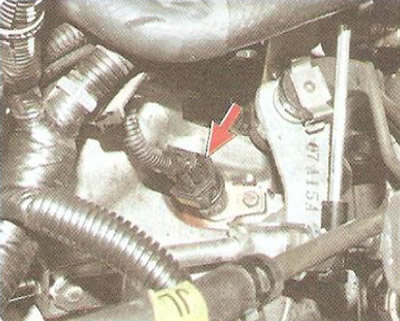
Speed sensor car is mounted on the gearbox.
You will need a socket wrench «on 10».
1. Disconnect the wire from the terminal «minus» battery.
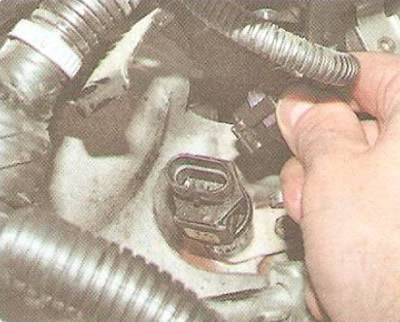
2. Wring out a clamp of a block of a plait of wires and disconnect a block from the gauge of speed.

3. Turn out a bolt of fastening...

4.... and remove the sensor together with the drive from the gearbox hole.

5. Unscrew the sensor from the actuator.
6. Install the speed sensor in the reverse order of removal.
To replace the control oxygen sensor perform the following operations.
You will need: keys «at 12» And «at 22».
Warning: Parts of the exhaust system become hot when the engine is running. Be careful if you carry out work to replace the oxygen concentration sensor! Let the parts cool.
1. Disconnect the wire from the terminal «minus» battery.

2. Squeeze the latch...

3.... and disconnect the block of the harness of the control oxygen concentration sensor.

4. Remove the exhaust manifold heat shield (see «Removal and installation of thermal screens»), passing through the hole in the screen a harness with a block.

5. Loosen the sensor...
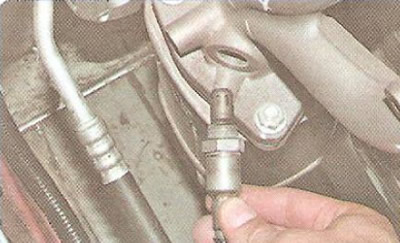
6.... and unscrew the sensor from the exhaust manifold.
7. Install the oxygen concentration control sensor in the reverse order of removal.
For replacement diagnostic oxygen concentration sensor perform the following operations.
You will need a key «at 22».
Warning: Parts of the exhaust system become hot when the engine is running. Be careful if you carry out work to replace the oxygen concentration sensor! Let the parts cool.
1. Disconnect the wire from the terminal «minus» battery.
2. Place the vehicle on a lift or pit.

3. Press the latch and disconnect the diagnostic oxygen concentration sensor harness connector.

4. Loosen the sensor with a wrench and unscrew the sensor from the exhaust pipe.
5. Install the diagnostic oxygen sensor in the reverse order of removal.
